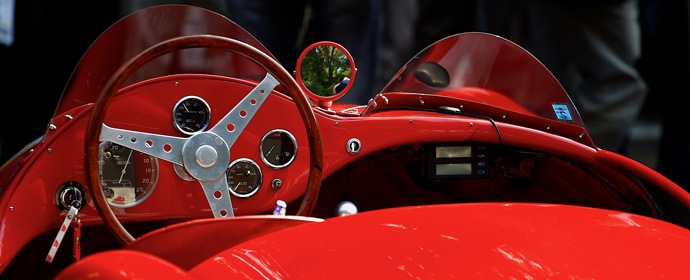Report and photos by Len Clarke
La Festa Autunno was held October 8-12, 2011, starting and ending in Tokyo.
Celebrating its 15th anniversary in 2011, La Festa Autunno is Japan’s most well-known historic rallying event, and attracts some of the finest machinery in this, a country filled with automotive works of art.
Begun in 1997, the event, originally known as La Festa Mille Miglia, took a feather from the cap of its Italian namesake, running the same 1,000 miles over a similarly grueling four-day schedule. From this year, a new name, “La Festa Autunno” is being used.
The event gets underway at one of the city’s most scenic spots, Meiji Shrine. The heavily wooded area around Meiji Jingu (as it’s known in Japanese) is an oasis in an otherwise bustling metropolis, providing respite literally steps away from one of the most popular shopping areas of the city.
While the schedule for the 2011 running hasn’t changed, the route is completely new. A result of March’s Great East Japan Earthquake, the entrants now head west out of the Tokyo starting point instead of north, visiting scenic spots that include the resort towns of Karuizawa and Kusatsu in Nagano prefecture before heading into Niigata and Gunma. The mountainous topography of the area makes for some breathtaking scenery.
This new route (subject to be amended to include the disaster-stricken area of Fukushima in coming years) was expertly chosen; the number of small towns and hamlets that crop up along the tight and twisty roads as competitors snake through the hills makes the visual impact constant and varied.
The later stages of the rally took competitors into the rural areas of Shizuoka prefecture and included an appearance at Fuji Speedway, where the cars were let loose on the 4.653km circuit located at the foot of Japan’s largest volcano, Mount Fuji. The final day began with a run through Hakone and over the famous Izu Skyline before the participants drove through the beach towns of Oiso, Enoshima and Hayama on their way to “Aka Renga”, the red brick warehouse area of Yokohama.
Similar to the start, hordes of onlookers were in attendance at the finish, also at Meiji Jingu. Some were there for the cars, while others were hoping to get a glimpse of some of the celebrities taking part.
The thing that’s most important at an event of this stature is, of course, the cars and the participants. Some of the most colourful people in Japan are amongst the entrants, and this, along with the rarity of the automobiles they bring to the rally causes the greatest stir.
La Festa Autunno 2011 never failed to deliver in terms of the quality of cars taking part. Marques and models many enthusiasts have never even heard of are a regular feature of the event. This year it was the 1948 Ermini 1100 Sport that really caught my eye. But there are all kinds of other low-volume constructors and coachbuilders represented, particularly strong among them is the Italian contingent from the 1940 and 1950s. Names like Stanguellini, Cisitalia, Osca, Roselli, Moretti, Bandini and Morassutti alongside the more familiar Maserati, Ferrari, Fiat and Alfa Romeo entries. Other rarities from that era included a Panhard Dyna, but earlier cars such as the 1927 BNC 527 Monza or 1931 Rally N.C.P. were most impressive.
Saving the best for last, it is the earliest cars that really hold my attention. The 2011 running was led away by a brace of no fewer than six Bugattis of varying models (including a trio of similarly-bodied T35C, T37A and T22/T13 entries). They were followed by examples of British makes Rolls-Royce, Bentley, Riley, Austin, Aston Martin and MG before the post-war group, the event’s largest, began streaming past.
As it is every year, La Festa is a celebration of the glory years of the automobile, both in terms of design and then-cutting edge technology. The cars also sound magical. However, it is the sight of these machines that really sets the heart racing. They just don’t make ‘em like that any more!
La Festa Autunno 2011 – Photo Gallery (click image for larger picture and description)
[envira-gallery id=”141402″]
—
[Source: Len Clarke]











The Etceterinis are bellisimo. Wonderful for bringing these pictures. Molto Grazie!
The early Maserati A6 coupe is so pedestrian-looking, especially when compared to its A6 GCS brother. Really enjoyed these pictures. Thanks Mr Clarke.
It is encouraging that there are people who appreciate fine automotive art in Japan, a country which has done more than any other to degrade the motorcar to the status of an appliance. “Finche’ c’e’ vita c’e’ speranza!”
Excellent piece and photos. Thanks.
How many cars participated ?